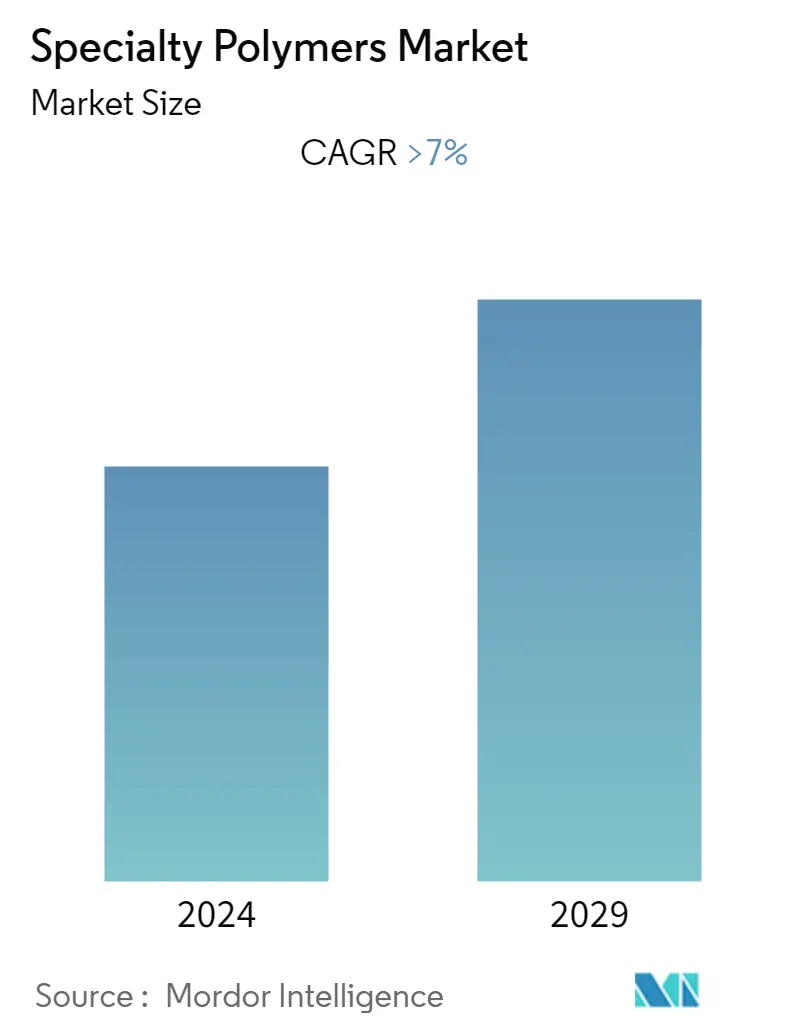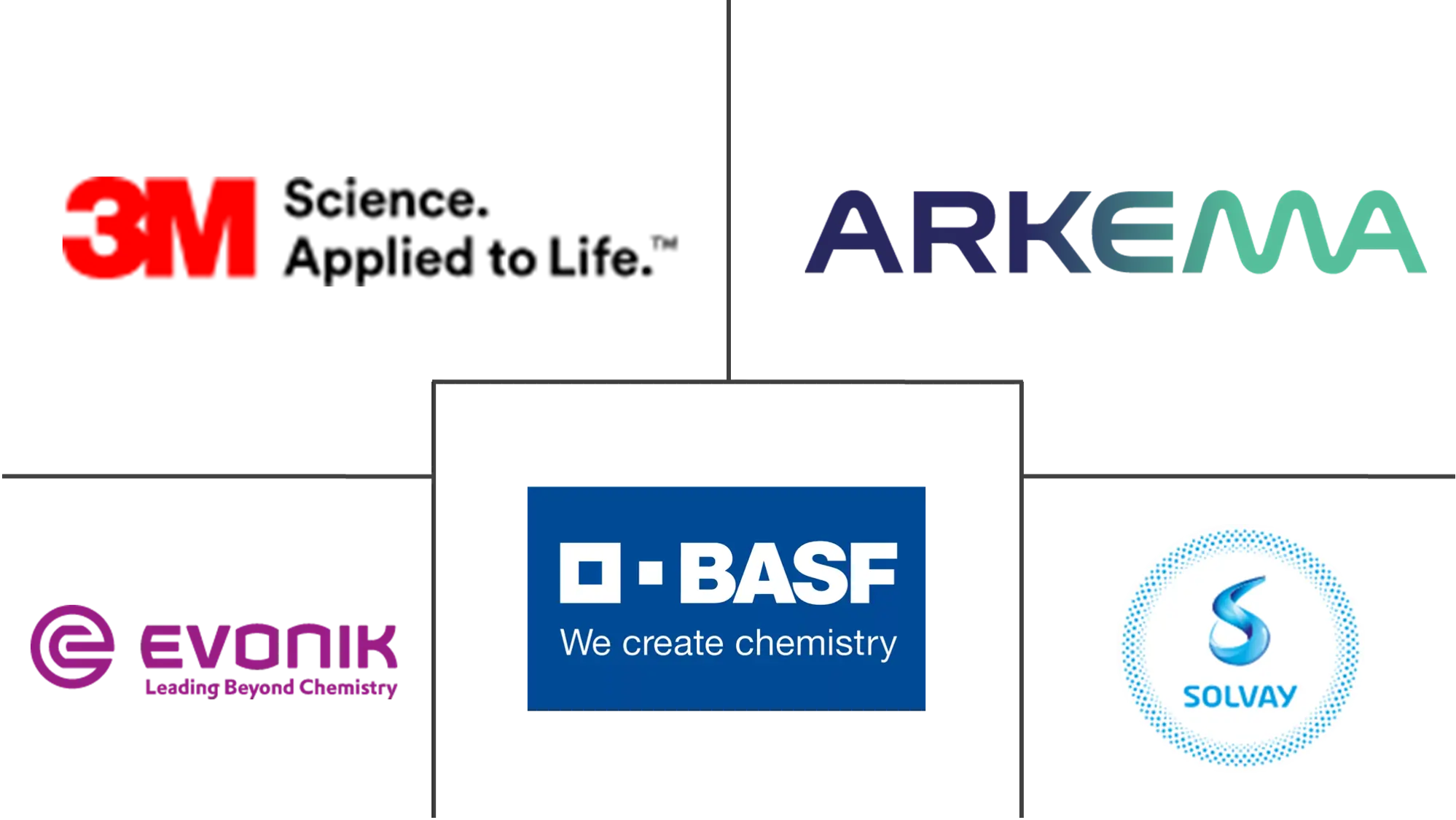Market Size of Specialty Polymers Industry

| Study Period | 2019 - 2029 |
| Base Year For Estimation | 2023 |
| CAGR | > 7.00 % |
| Fastest Growing Market | Asia Pacific |
| Largest Market | Asia Pacific |
| Market Concentration | Low |
Major Players
*Disclaimer: Major Players sorted in no particular order |
Specialty Polymers Market Analysis
The global speciality polymers market is expected to record a CAGR of over 7% during the forecast period.
The market was negatively impacted by the COVID-19 outbreak in 2020. Owing to the pandemic scenario, several countries went into lockdown, which led to supply chain disruptions, work stoppages, and labour shortages. However, the sector is recovering well since restrictions were lifted. An increase in house sales and new project launches have led to a rise in the demand for coatings, sealants, and construction chemicals. The increasing demand for healthcare, electrical, and electronics is leading the market recovery over the last two years.
- The major factors driving the market studied are the increasing applications in the construction and electronic industries, the commercialization of lightweight polymers for automotive and aerospace applications, and the growing availability of feedstock derived from natural gas and crude oil processing.
- Fluctuating operational costs to derive feedstock and technological obsolescence due to constantly changing end-user needs are expected to hinder the market's growth.
- Emerging specialty polymer technologies in various industrial applications and prolific commercialization of engineered polymer and specialty film products are likely to act as opportunities for the market studied over the forecast period.
- Asia-Pacific emerged as the largest market and is expected to witness the highest CAGR during the forecast period. This dominance of Asia-Pacific is attributed to the high demand in countries such as China, Japan, and India.
Specialty Polymers Industry Segmentation
Specialty Polymers are the class of some High-Performance Polymers (HPP), including plastics, polymers, fluids, membranes, smart hydrogels, and elastomers. They meet the critical requirements that engineers face daily in crucial industries such as Plastics, Automobiles, Aeronautics, Smart Devices, etc. Specialty polymers are characterized by their ability to retain desirable mechanical, thermal, and chemical properties when subjected to harsh environments, such as high temperature, high pressure, and corrosive chemicals. The specialty polymers market is segmented by type, end-user industry, and geography. By type, the market is segmented into specialty elastomers, specialty composites, specialty thermoplastics, specialty thermosets, and other types. The market is segmented by end-user industry into automotive and transportation, consumer goods, building and construction, coatings, adhesives, sealants, electrical and electronics, healthcare, and other end-user industries. The report also covers the market size and forecasts for the specialty polymer market in 15 countries across major regions. For each segment, the market sizing and forecasts have been done based on revenue (USD million).
| Type | |
| Specialty Elastomers | |
| Specialty Composites | |
| Specialty Thermoplastics | |
| Specialty Thermosets | |
| Other Types |
| End-user Industry | |
| Automotive and Transportation | |
| Consumer Goods | |
| Building and Construction | |
| Coatings, Adhesives, and Sealants | |
| Electrical and Electronics | |
| Healthcare | |
| Other End-user Industries |
| Geography | |||||||
| |||||||
| |||||||
| |||||||
| |||||||
|
Specialty Polymers Market Size Summary
The specialty polymers market is poised for significant growth, driven by increasing applications in the construction, electronics, and automotive industries. The market is recovering from the setbacks caused by the COVID-19 pandemic, which had led to supply chain disruptions and labor shortages. The demand for specialty polymers is bolstered by their advantageous properties, such as thermal resistance and wear resistance, making them ideal for use in automotive and transportation sectors. The shift towards lightweight and fuel-efficient vehicles is further propelling the use of these polymers, as they replace heavier metals to reduce vehicle weight and improve fuel efficiency. The market is also experiencing opportunities through emerging technologies and the commercialization of engineered polymer products, despite challenges like fluctuating operational costs and technological obsolescence.
Asia-Pacific is the largest and fastest-growing region in the specialty polymers market, with China, Japan, and India leading the charge due to their expanding automotive and electrical industries. The region's growth is supported by economic development and increasing per capita income, with China focusing on boosting electric vehicle production. The electronics sector's growth, driven by digitalization and export expansion, is also contributing to the rising demand for specialty polymers. The market is characterized by fragmentation, with key players like 3M, Arkema Group, BASF SE, Evonik Industries AG, and Solvay actively participating. Recent collaborations and innovations, such as Evonik's distribution partnerships and Arkema's recycled polyamides, highlight the dynamic nature of the market, which is expected to continue its upward trajectory over the forecast period.
Specialty Polymers Market Size - Table of Contents
-
1. MARKET DYNAMICS
-
1.1 Drivers
-
1.1.1 Increasing Applications in the Construction and Electronic Industries
-
1.1.2 Commercialization of Lightweight Polymers for Automotive and Aerospace Applications
-
1.1.3 Increasing Availability of Feedstock Derived from Natural Gas and Crude Oil Processing
-
-
1.2 Restraints
-
1.2.1 Fluctuating Operational Costs to Derive Feedstock
-
1.2.2 Technological Obsolescence due to Constantly Changing End-user Needs
-
-
1.3 Industry Value Chain Analysis
-
1.4 Porter's Five Forces Analysis
-
1.4.1 Bargaining Power of Suppliers
-
1.4.2 Bargaining Power of Buyers
-
1.4.3 Threat of New Entrants
-
1.4.4 Threat of Substitute Products and Services
-
1.4.5 Degree of Competition
-
-
-
2. MARKET SEGMENTATION (Market Size in Value)
-
2.1 Type
-
2.1.1 Specialty Elastomers
-
2.1.2 Specialty Composites
-
2.1.3 Specialty Thermoplastics
-
2.1.4 Specialty Thermosets
-
2.1.5 Other Types
-
-
2.2 End-user Industry
-
2.2.1 Automotive and Transportation
-
2.2.2 Consumer Goods
-
2.2.3 Building and Construction
-
2.2.4 Coatings, Adhesives, and Sealants
-
2.2.5 Electrical and Electronics
-
2.2.6 Healthcare
-
2.2.7 Other End-user Industries
-
-
2.3 Geography
-
2.3.1 Asia-Pacific
-
2.3.1.1 China
-
2.3.1.2 India
-
2.3.1.3 Japan
-
2.3.1.4 South Korea
-
2.3.1.5 Rest of Asia-Pacific
-
-
2.3.2 North America
-
2.3.2.1 United States
-
2.3.2.2 Canada
-
2.3.2.3 Mexico
-
-
2.3.3 Europe
-
2.3.3.1 Germany
-
2.3.3.2 United Kingdom
-
2.3.3.3 Italy
-
2.3.3.4 France
-
2.3.3.5 Rest of Europe
-
-
2.3.4 South America
-
2.3.4.1 Brazil
-
2.3.4.2 Argentina
-
2.3.4.3 Rest of South America
-
-
2.3.5 Middle-East and Africa
-
2.3.5.1 Saudi Arabia
-
2.3.5.2 South Africa
-
2.3.5.3 Rest of Middle-East and Africa
-
-
-
Specialty Polymers Market Size FAQs
What is the current Specialty Polymers Market size?
The Specialty Polymers Market is projected to register a CAGR of greater than 7% during the forecast period (2024-2029)
Who are the key players in Specialty Polymers Market?
3M, Arkema Group, BASF SE, Evonik Industries AG and Solvay are the major companies operating in the Specialty Polymers Market.

